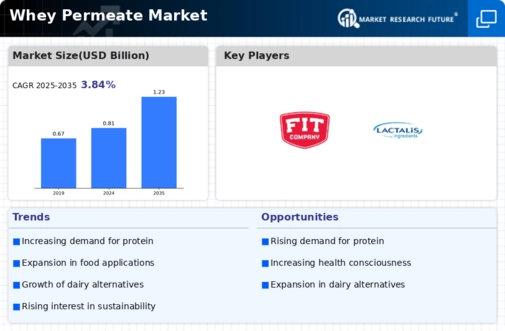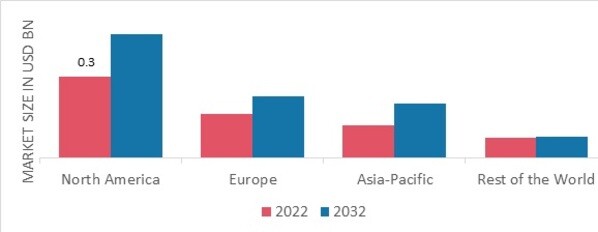Market Analysis
Whey Permeate Market (Global, 2024)
Introduction
Whey permeate market is expected to witness substantial growth over the forecast period, as demand for dairy-based ingredients continues to rise across several industries, such as food & beverage, nutrition, and animal feed. The use of whey permeate is gaining momentum owing to its nutritional and functional properties. In addition, manufacturers are increasingly trying to improve the quality of their products, while maintaining a competitive price. Moreover, the growing trend of clean labeling and the growing health consciousness among consumers are expected to further boost the whey permeate market. Also, the increasing demand for whey permeate in the food industry and the introduction of newer processing methods and its increasing application scope in various industries are expected to make the whey permeate market a lucrative avenue for the market players.
PESTLE Analysis
- Political
- The whey permeate market in 2024 will be affected by various political factors, including government policies on dairy production and food safety. In the European Union, there are strict regulations on food additives and dairy products, and more than 50% of the member countries have tightened the quality of whey permeate. In addition, the EU-Mercosur agreement on tariff reduction on agricultural products will have an impact on the import and export of whey permeate, and the export and import volume may increase by 15% in the next five years.
- Economic
- In 2024, the economic landscape for the whey permeate market will be shaped by fluctuations in milk prices and the spending of consumers. Whey permeate is priced at around 0.30 € per kg. This price is up 10 % on the previous year due to rising feed prices and supply disruptions. The whey permeate market is expected to grow further as it is a key ingredient in many food products and is therefore driving demand and economic activity.
- Social
- The social trends in 2024 show a growing preference for a high-protein diet, which has a positive effect on the whey permeate market. Surveys show that 65% of consumers are actively looking for high-protein food, which means that whey permeate will be increasingly used in health and food supplements and food fortification. Furthermore, the fitness culture and the awareness of the nutritional benefits have led to a 20 % increase in the consumption of protein supplements among millennials and generation Z, which will increase the demand for whey permeate as a cost-effective source of protein.
- Technological
- In 2024, the technological developments in the processing and production methods will have a significant influence on the whey permeate market. The development of membrane filtration has improved the extraction efficiency of whey permeate and has reduced the production costs by approximately 15%. In addition, the automation of the dairy plants has increased the production capacity by approximately 25%, thereby enabling the manufacturers to meet the increasing demand for whey permeate in the various applications, such as in the food and beverage industries.
- Legal
- In 2024, legal factors affecting the whey permeate market include food safety regulations and labeling requirements. Whey permeate in food products must be clearly labeled. This will affect more than 30% of the market, as producers will have to modify their packaging and marketing strategies. In addition, the implementation of the Food Safety Modernization Act (FSMA) has led to increased inspections of dairy processing plants. The number of inspections has increased by 40% in the past year, and products are now subject to higher quality and safety standards.
- Environmental
- In 2024, the whey permeate market is increasingly concerned with the environment, especially with regard to the sustainable use of dairy farms. The use of waste and water is being increasingly reduced in a number of dairy farms. Almost 60% of dairy farms are now adopting eco-friendly practices such as waste recovery and water saving. In addition, the dairy industry is under pressure to reduce greenhouse gas emissions by a quarter by 2030. This has a significant impact on the production and sourcing of whey permeate, which is adapted to the goal of sustainable development.
Porter's Five Forces
- Threat of New Entrants
- Barriers to entry are medium in the whey permeate market because of the need for specialized equipment and knowledge of dairy processing. While the market is growing, established companies have built strong brands and distribution networks that could make it difficult for new entrants to compete. But the growing demand for whey permeate in a variety of applications could attract new competitors.
- Bargaining Power of Suppliers
- “The suppliers of whey permeate are relatively numerous, since whey is a by-product of cheesemaking.” “Therefore, the manufacturer has a wide choice, which reduces the bargaining power of individual suppliers.” “Besides, the raw materials for the manufacture of whey permeate are generally plentiful, which also limits the power of the suppliers.”
- Bargaining Power of Buyers
- The market for whey permeate is highly concentrated, owing to the availability of substitutes and the presence of many suppliers. The purchasers of whey permeate are looking for cost-effective solutions and therefore negotiating better prices and conditions. This may affect the suppliers’ profitability.
- Threat of Substitutes
- Whey permeate has a limited number of applications, but there are alternatives, such as other dairy by-products or plant-based proteins, that can perform the same function. The threat of substitution is moderate, as whey permeate's unique properties may not be easily replicated. Nevertheless, the growing popularity of plant-based alternatives may be a threat in the long term.
- Competitive Rivalry
- The whey permeate market is characterized by a high level of competition among both established and new entrants. In order to gain market share, companies are constantly developing new products, launching price strategies and expanding distribution networks. This competition leads to price wars and increased marketing expenditure, which has a negative effect on the market's overall profitability.
SWOT Analysis
Strengths
- High nutritional value and functional properties of whey permeate.
- Growing demand for protein-rich food products among health-conscious consumers.
- Cost-effective ingredient for food and beverage manufacturers.
- Versatile applications in various industries including dairy, bakery, and sports nutrition.
Weaknesses
- Limited consumer awareness about whey permeate compared to other dairy products.
- Potential quality variations based on sourcing and processing methods.
- Perception issues related to dairy allergies and lactose intolerance.
- Dependency on the dairy industry, which can be affected by fluctuations in milk supply.
Opportunities
- Expansion of the health and wellness trend driving demand for functional ingredients.
- Increasing use of whey permeate in plant-based and alternative protein products.
- Potential for innovation in product formulations and new applications.
- Growing markets in developing regions where dairy consumption is rising.
Threats
- Intense competition from other protein sources and ingredients.
- Regulatory challenges and changing food safety standards.
- Market volatility due to fluctuations in raw material prices.
- Consumer trends shifting towards plant-based diets may impact demand.
Summary
Whey permeate is characterized by its nutritional value and cost-effectiveness, which makes it a valuable ingredient in various food applications. The low level of consumer awareness and the dependency on the dairy industry are risk factors. Opportunities lie in the trend towards healthy and natural products and in the possibility of developing new products. Competition from other protein sources and the regulatory environment could limit the growth of the market, so strategic positioning and consumer education are required.







Leave a Comment